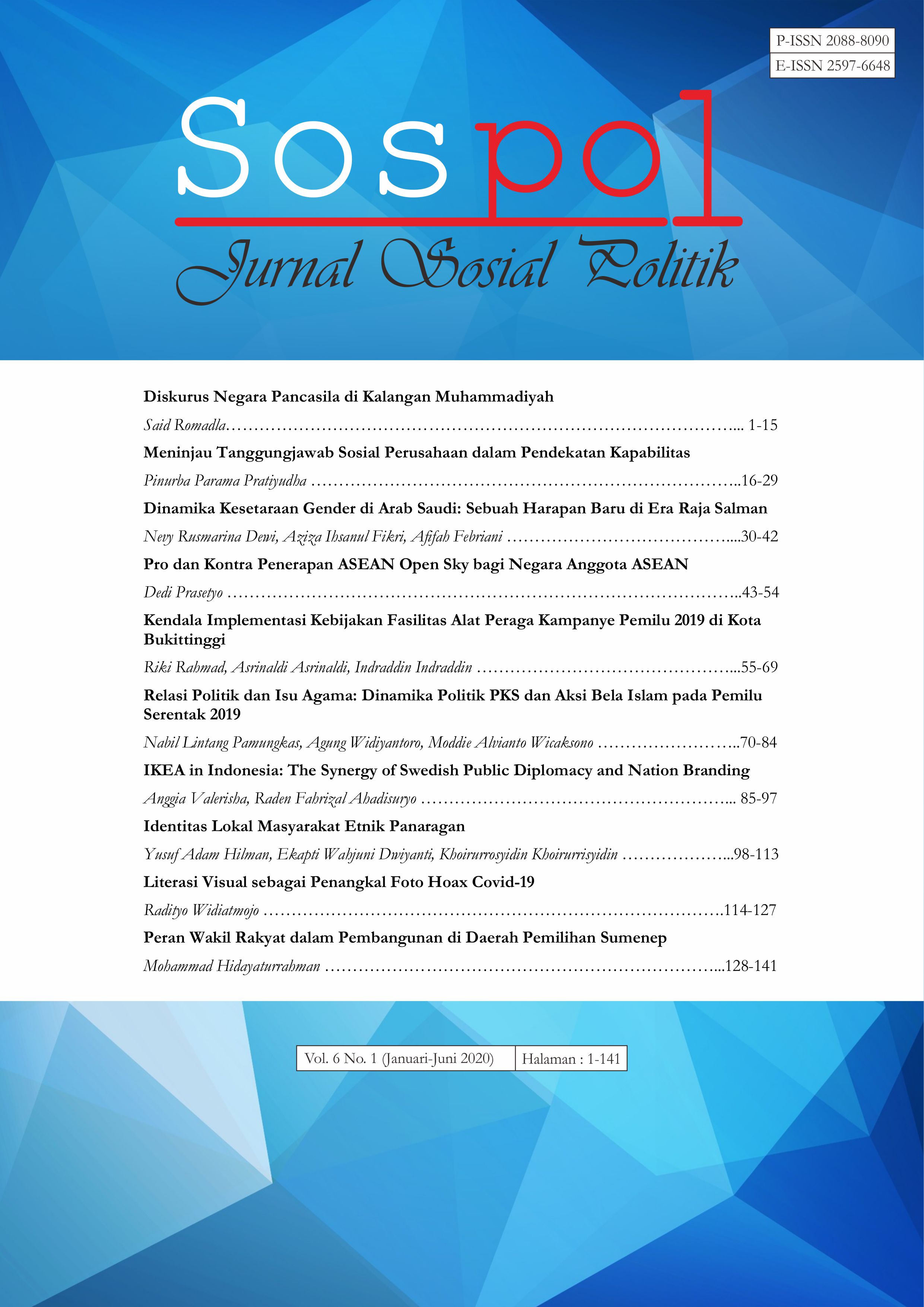Literasi Visual Sebagai Penangkal Foto Hoax Covid-19
DOI:
https://doi.org/10.22219/sospol.v6i1.11221Keywords:
Covid-19, Digital Communication, Hoax, Photography, Visual Literacy.Abstract
The spread of hoax on health issue is a compelling phenomenon in digital era. By focusing on visual literacy as a way to avoid hoax, this qualitative research attempts to find how visual hoax operated. The main concept of Visual Literacy proposed by Maria Avgerinou, reading the spectrum of an image by Roland Barthes and six dimension of photograph life by Widiatmojo are used to analysis visual hoax. The result shows that visual hoax on corona virus occurred as the time frame dimension were diminished, the meaning was changed as well as the narration of the original image, the topic was compromised, the lost of image quality and the distribution on social media by anonymous identity. Therefore, people need to have basic competence in visual literacy, which is the ability to understand visual language accompanied by the ability to think and analyze. It will make an individual produce a positive perception that should be use to avoid hoaxes.
Downloads
References
Ausburn, L. J., & Ausburn, F. B. (1978). Innovations in Education & Training International Visual Literacy : Background , Theory and Practice Visual Literacy : Background , Theory and Practice, (December), 37–41. https://doi.org/10.1080/0033039780150405
Avgerinou, M. (2009). Re-Viewing Visual Literacy in the “ Bain d ’ Images ” Era. TechTrends, 53(2), 28–34. https://doi.org/10.1007/s11528-009-0264-z
Avgerinou, M. (2011). Toward a Cohesive Theory of Visual Literacy Toward a Cohesive Theory of Visual Literacy, 6529(March), 1–19. https://doi.org/10.1080/23796529.2011.11674687
Avgerinou, M., & Ericson, J. (1997). A review of the concept of Visual Literacy, 28(4), 280–291.
Barthes, R. (1981). Camera Lucida: Reflections on Photography. New York: Hill and Wang.
BeKraf. (2016). Profil Usaha/Perusahaan 16 Subsektor Ekraf. Jakarta.
Bradent, R. A., Hortinf, J. A., & Hortin, J. A. (1982). Identifying The Theoretical Foundations of Visual Literacy by, 7525(July). https://doi.org/10.1080/23796529.1982.11674354
Hicks, R. F. S. (2001). Medium and Large Format Photography, Moving Beyond 35mm for Better Pictures. New York: Watson-Guptill.
Kedra, J. (2018). What does it mean to be visually literate? Examination of visual literacy definitions in a context of higher education. Journal of Visual Literacy, 67–84. https://doi.org/10.1080/1051144X.2018.1492234
Khoirul, A. (2020). Beredar rekaman mengerikan mayat-mayat tergeletak di jalanan Wuhan akibat virus corona ternyata beginilah fakta sebenarnya. Retrieved January 29, 2020, from https://intisari.grid.id/read/032003877/beredar-rekaman-mengerikan-mayat-mayat-tergeletak-di-jalanan-wuhan-akibat-virus-coronya-ternyata-beginilah-fakta-sebenarnya?page=all
Kominfo. (2020). Laporan Isu Hoaks. Jakarta. Retrieved from https://www.kominfo.go.id/content/all/laporan_isu_hoaks
Kompas. (2020). Tidak bisa musiman mengatasi hoaks politik. Retrieved from https://kompas.id/baca/utama/2020/01/20/tidak-bisa-musiman-mengatasi-hoaks-politik/
Martin, J. N. (2014). Intercultural Communication in Contexts. New York: McGraw-Hill.
Moholy-Nagy, L. (1936). From Pigmen to Light. In Photography in Print (pp. 339–348). Chicago: Bauhaus.
Nfsw. (2020). Screenshoot facebook via WhatsApp. Malang.
Peres, M. R. (2007). The Focal Encyclopedia of Photography. Oxford: Focal Press.
Poerwandari, K. (2007). Pendekatan Kualitatif Untuk Penelitian Perilaku Manusia. Jakarta: LPSP3.
Richard, E. (2016). Visual Literacy and the Digital Native: Another Look. Journal of Visual Literacy, 7–26. https://doi.org/10.1080/23796529.2013.11674703
Soedjono, S. (2019). Fotografi Surealisme Visualisasi Estetis Citra Fantasi Imajinasi. REKAM, 1–12. https://doi.org/10.24821/rekam.v15i1.3341
Solomon-Godeau, A. (2017). Photography After Photography. London: Duke University Press.
Sontag, S. (1977). On Photography. New York: Farrar, Straus and Giroux.
Sunardi. (2004). Semiotika Negativa. Yogyakarta: Buku Baik.
Tribunnews. (2020). Beredar Foto Hoaks Mayat Korban Virus Corona di WhatsApp, Sejumlah Orang Bergelimpangan di Jalan. Retrieved from https://www.tribunnews.com/nasional/2020/01/28/beredar-foto-hoaks-mayat-korban-virus-corona-di-whatsapp-sejumlah-orang-bergelimpangan-di-jalan?page=2
Wellz, L. (2015). Photograhy: A Critical Introduction. New York: Routledge.
WHO. (2020a). Coronavirus disease (COVID-19): Situation Report – 120. Retrieved from https://www.who.int/docs/default-source/coronaviruse/situation-reports/20200519-covid-19-sitrep-120.pdf?sfvrsn=515cabfb_2
WHO. (2020b). Novel Coronavirus (2019-nCoV) - Situation Report 63. Retrieved from https://www.who.int/docs/default-source/coronaviruse/situation-reports/20200323-sitrep-63-covid-19.pdf?sfvrsn=d97cb6dd_2
Widiatmojo, R. (2016). Kekerasan Simbolik Terhadap Perempuan Dalam Fotografi Portrait di Group Facebook: Studi pada Komunitas Fotografi Indonesia. Jurnal Komunikasi Indonesia, 112–123. https://doi.org/10.7454/jki.v5i2.8906
Widiatmojo, R. (2018). Analisis Semiotik Kebun Binatang Dalam Photobook Berjudul Wildtopia. SOSPOL, 108–123. https://doi.org/10.22219/sospol.v4i2.6791
Widiatmojo, R. (2019). Literasi Visual Sebagai Penangkal Foto Hoaks di Era Digital. In Demokrasi Damai Era Digital (p. 34). Jakarta: SiberKreasi.
Wieczorek-Tomaszewska, M. (2016). The Research on Visual Literacy in Transliteracy as the main Ability and Communicate in the 21st Century. International Journal of Research in E-Learning, 2(2), 31–50. Retrieved from https://depot.ceon.pl/bitstream/handle/123456789/14355/02 Małgorzata Wieczorek-Tomaszewska.pdf?sequence=1&isAllowed=y
Downloads
Published
How to Cite
Issue
Section
License
Authors who publish with this journal agree to the following terms:
- Authors retain copyright and grant the journal right of first publication with the work simultaneously licensed under a Creative Commons Attribution-ShareAlike 4.0 International License that allows others to share the work with an acknowledgement of the work's authorship and initial publication in this journal.
- Authors are able to enter into separate, additional contractual arrangements for the non-exclusive distribution of the journal's published version of the work (e.g., post it to an institutional repository or publish it in a book), with an acknowledgement of its initial publication in this journal.
- Authors are permitted and encouraged to post their work online (e.g., in institutional repositories or on their website) prior to and during the submission process, as it can lead to productive exchanges, as well as earlier and greater citation of published work (See The Effect of Open Access).

This work is licensed under a Creative Commons Attribution-ShareAlike 4.0 International License.



















